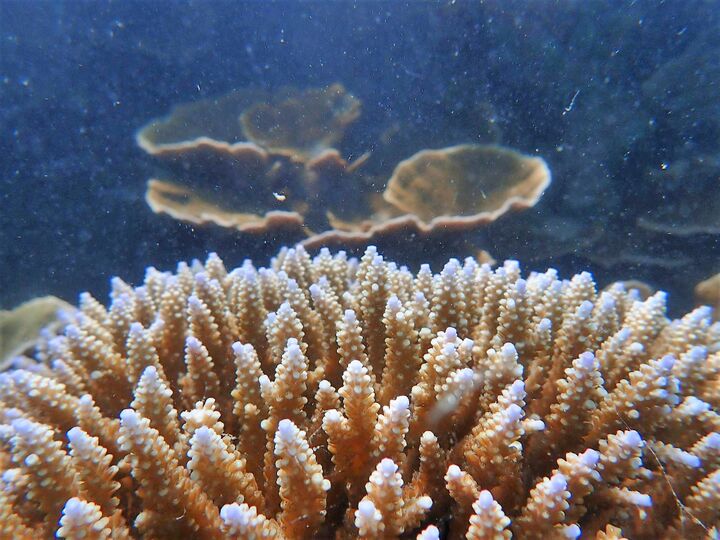Vernon Islands Reef Walk and Snorkel

We were expecting a big tide, and a big tide it was. Partnering with The Northern Territory branch of the Australian Marine Science Association and The Northern Territory Field Naturalists' Club, we hosted a big day out to the Vernon Islands for a Guided Reef Walk and/or Blue Holes snorkel. We were swamped with interest in this excursion, and so grateful for the support of the Mantiyupwi Clan in allowing us to showcase their saltwater country. It was a such a privilege to have Dr Richard Willan provide expert commentary on the reef, and his report below from Nature Territory (the newsletter of the NT Field Naturalists’ Club) demonstrates that his skills are not just in the great outdoors, but he is a whizz of a wordsmith as well.
October Field Trip Report Excursion to the Vernon Islands – 9 October 2021
Report by Richard Willan
"On 15 September, the billionaire Elon Musk paid undisclosed millions for a three day space flight for four friends to a height of 585 km above the Earth. As they circled, the passengers on board SpaceX Inspiration4glued themselves to a bubble-shaped window added to the top of the cramped capsule to look back at their little blue home planet. There was no professional astronaut on board. The return from orbit followed a plunge through Earth’s atmosphere generating frictional heat that sent the temperatures surrounding the outside of the capsule soaring to 1,927 degrees Celsius. Compare this excursion with the one that 40 people experienced in October to the Vernon Islands northeast of Darwin. These fortunate people escaped the oppressive 35 degrees Celsius for a day enjoying ‘inner space’ by getting wet and weightless. They saw even more beautiful sights than distant stars, and had two professional marine biologists as guides.
The Vernons straddle Clarence Strait between the Beagle and Van Diemen Gulfs where the seawater surrounding them is permanently clear. In fact, the clear water and the diversity of marine life we saw at the Vernons could have been those surrounding an inshore coral atoll on Great Barrier Reef. This diversity of marine life greatly exceeds that of silty Darwin Harbour. The Vernons are renowned for the series of Blue Holes ‒ large ones and small ones ‒ that puncture the reef flats surrounding them. These holes were formed by erosion by rain and chemical weathering of the limestone-rich terrain during past ice ages.
The excitement commenced the moment the two ‘Sea Darwin’ boats, Flatback and Olive Riddley, idled to locate a landing site close to the large Blue Hole on the northern side of North West Vernon Island. At the same instant, the people on the port side of one boat saw a sea turtle whilst those on the starboard side of the other boat saw a flying fish. Then everyone looked down and they could easily make out the bottom festooned with enormous Leather Corals (Sarcophyton sp.).
Once ashore, about half the people rushed across an ‘uninteresting’ bank of coral rubble to snorkel in the largest Blue Hole of the whole series on the Vernons. They were impressed by the luxuriance and beauty underwater. The walls of this hole were festooned with tall vase and staghorn corals and the water shimmered from schools of brightly coloured fishes. The other group spent the time investigating the rubble bank itself, which they quickly discovered was far from uninteresting. It supported a myriad of colourful life representing some 15 phyla of animals and plants, several of which have no representatives on land. The rubble was mostly low, hardy, turfing hard corals and crust-forming red seaweeds. Many of the animals were behaving as normal unaware that the tide was racing past them. The Northern Greater Blue-ringed Octopuses ( Hapalochlaena sp.) – we saw 10 of them – were out and hunting for crustaceans in only a few centimetres of water and they only flashed their vivid rings when they were about to be stepped on. I was surprised to see so many of these deadly little octopuses and that they were all half grown. Equally energetic were the mantis shrimps (Gonodactylus sp.) and Ass’ Ear Abalone (Haliotis asinina). Other animals had already come to a standstill as they realised the water was getting low and hot above them – such as Dauphin Snails (Angaria sp.), Laminated Turban Snails (Turbo laminiferus) and Hairy Crabs (Pilumnus vespertilio). Mind you, Hairy Crabs are never renowned for speediness!
After an hour of emersion, the hard corals were all glistening as they pumped mucous over their skeletons to prevent sunburn. When this mucous formed a clear film over the surface of the water that began to ripple ever so slightly we knew the tide had turned and we had to get back to our boats. The boats pulled away gently and rafted up a short distance offshore where our aquanauts thanked the Northern Territory Branch of the Australian Marine Science Association for organising this memorable trip. They also thanked Jim Smith and his crew from ‘Sea Darwin’ for a safe day’s outing to blue ‘inner space’. All of them claimed that this trip was much more enjoyable and more exciting than any space flight could ever be."